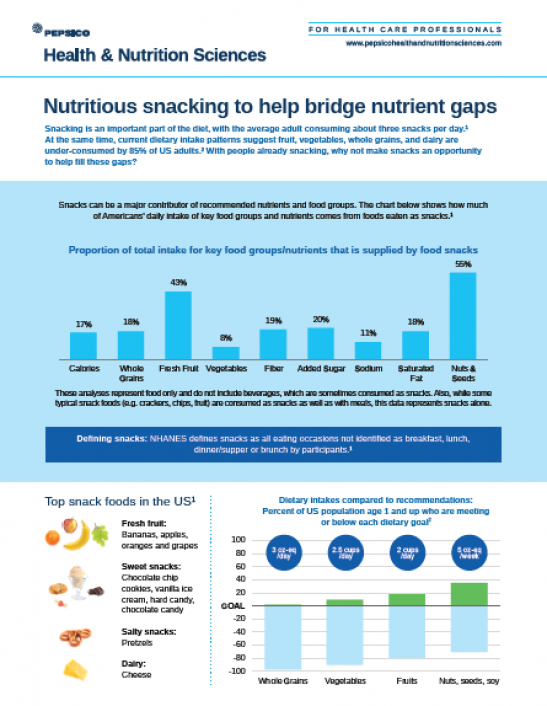Nutritious Snacking to Help Bridge Nutrient Gaps
Please click on "Click to view" or on the image to the right to download this resource to use with your patients and clients!
Description: Learn about how snacks play an important role in the diet.
- Contribution of snacks toward food groups & nutrients
- Nutritious Snack ideas
Nutritious snacking to help bridge nutrient gaps
Snacking is an important part of the diet, with the average adult consuming about three snacks per day.1 At the same time, current dietary intake patterns suggest fruit, vegetables, whole grains, and dairy are under-consumed by 85% of US adults.2 With people already snacking, why not make snacks an opportunity to help fill these nutrient gaps?
Snacks can be a major contributor of recommended nutrients and food groups. The chart below shows how much of Americans’ daily intake of key food groups and nutrients comes from foods eaten as
snacks.1
What is the definition of a snack?
NHANES defines snacks as all eating occasions not identified as breakfast, lunch, dinner/supper or brunch by participants.1
Top snack foods in the US1
- Fresh fruit: Bananas, apples, oranges and grapes
- Sweet snacks: Chocolate chip cookies, vanilla ice cream, hard candy, chocolate candy
- Salty snacks: Pretzels
- Dairy: Cheese
How to create nutritious snacks that meet nutrient gaps
WHOLE GRAINS
- Snacks can be a great source of whole grains, with approximately 18% of US adults’ total whole grain intake coming from snacks.1
- Whole grains can be a significant, cost-effective source of B vitamins, minerals and fiber.3
VEGETABLES
- Currently 8% of total vegetable intake comes from snacks,1 with lots of room to grow.
- Diets that provide high vegetable intake are linked to improved digestive health and reduced risk of heart disease, diabetes, obesity and some cancers.4
FRESH FRUIT
- Snacking contributes significantly to fresh fruit intake; around 43% of whole fruit consumption comes from snacks.1
- Fruit is an important source of vitamins and minerals, including vitamin C, fiber and potassium.4
NUTS & SEEDS
- On average, over half of dietary nuts and seeds intake in the US is from snacks.2
- Evidence suggests consuming nuts as part of a diet low in saturated fat may help lower cholesterol and reduce the risk of heart disease.5
FIBER
- Only around 5% of Americans get the recommended amount of dietary fiber they need each day.6
- Increasing consumption of fruits, vegetables, nuts and whole grains as part of snacks provides an opportunity to help adults increase their fiber intake.
Please click on "Click to view" or on the image to the right to download this resource to use with your patients and clients!
References:
- Centers for Disease Control and Prevention (CDC). National Center for Health Statistics (NCHS). National Health and Nutrition Examination Survey Data. Hyattsville, MD: U.S. Department of Health and Human Services, Centers for Disease Control and Prevention, 2017-2018 [NHANES 2017-2018 Dietary Data (cdc.gov)]
- U.S. Department of Agriculture and U.S. Department of Health and Human Services. Dietary Guidelines for Americans, 2020-2025. 9th Edition. December 2020. Available online: https://www.dietaryguidelines.gov/sites/default/files/2020-12/Dietary_Guidelines_for_Americans_2020-2025.pdf
- Brauchla M, Fulgoni VL. Public Health Nutrition. 2021 Feb 8:1-8
- Slavin JL, Lloyd B. Advances in Nutrition. 2012 Jul 3(4) 506-516
- Ros E. Nutrients. 2010 2(7):652-82
- Quagliani D, Felt-Gunderson P. American journal of lifestyle medicine. 2016;11(1):80-85.
